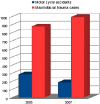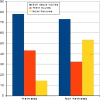The impact of mandatory helmet law on the outcome of maxillo facial trauma: a comparative study in kerala
- PMID: 24822010
- PMCID: PMC4016405
- DOI: 10.1007/s12663-013-0496-5
The impact of mandatory helmet law on the outcome of maxillo facial trauma: a comparative study in kerala
Abstract
Introduction: Motorcyclists comprise the majority of road-traffic victims in low and middle income countries,and consequently, the majority of the road-traffic victims globally. Simple measures can be taken to make safer on the roads, which include enforcement of safety measures like seat belt and helmets. The compulsory Helmet law was enforced in Kerala on 18/06/07. Resistance to legislation on motorcycle helmets still coexists world wide with debate on the effectiveness of helmets. In an attempt to analyze the protective effect of helmets on facial injuries a comparative study was conducted in Government Dental College, Calicut, which is a major trauma centre in northern Kerala.
Methods: Data for the present study was obtained from the patients who have reported to the Emergency Department of Oral and Maxillofacial Surgery, Government Dental College, Calicut, for a period of 6 months immediately after the implementation of strict helmet rule in Kerala. For the study all patients with a history of nonfatal motor cycle accident sustaining facial injuries were included. The results were compared with the study conducted in the same institution in the pre law period.
Results: The study demonstrates the protective effect of motorcycle helmets in decreasing the morbidity of maxillofacial trauma.There was a marked decrease in incidence of motorcycle-related injuries, remarkable increase in helmet usage and better outcome in helmeted individuals in the post law period.
Conclusion: Road traffic injury control is a public health problem. Health and medical professionals have an ethical responsibility to educate and arrange for the safety of individuals. Helmets are effective in preventing or reducing the severity of motorcycle-related injuries and in a developing country like India, enforced mandatory motor cycle helmet law is potentially one of the most cost effective interventions available.
Keywords: Helmet law; Kerala; Maxillofacial injuries; Motor cycle truma.
Figures






Similar articles
-
The immediate impact of mandatory helmet law on maxillo-facial trauma: A comparative study in a major trauma center, Uttar Pradesh.Natl J Maxillofac Surg. 2024 Jan-Apr;15(1):116-120. doi: 10.4103/njms.njms_313_21. Epub 2024 Mar 19. Natl J Maxillofac Surg. 2024. PMID: 38690257 Free PMC article.
-
Changing Trends in the Pattern of Maxillofacial Injuries in Helmeted Motorcycle Accident Patients when Compared to Non-helmeted Motorcycle Accident Patients.J Maxillofac Oral Surg. 2023 Mar;22(1):18-24. doi: 10.1007/s12663-021-01650-w. Epub 2021 Oct 6. J Maxillofac Oral Surg. 2023. PMID: 36703678 Free PMC article.
-
The Role of Helmet Fastening in Motorcycle Road Traffic Accidents.Craniomaxillofac Trauma Reconstr. 2019 Dec;12(4):284-290. doi: 10.1055/s-0039-1685458. Epub 2019 Mar 29. Craniomaxillofac Trauma Reconstr. 2019. PMID: 31719953 Free PMC article.
-
Helmet Regulation in Vietnam: Impact on Health, Equity, and Medical Impoverishment.In: Mock CN, Nugent R, Kobusingye O, Smith KR, editors. Injury Prevention and Environmental Health. 3rd edition. Washington (DC): The International Bank for Reconstruction and Development / The World Bank; 2017 Oct 27. Chapter 11. In: Mock CN, Nugent R, Kobusingye O, Smith KR, editors. Injury Prevention and Environmental Health. 3rd edition. Washington (DC): The International Bank for Reconstruction and Development / The World Bank; 2017 Oct 27. Chapter 11. PMID: 30212106 Free Books & Documents. Review.
-
Primary prevention of road traffic accident-related traumatic brain injuries in younger populations: a systematic review of helmet legislation.J Neurosurg Pediatr. 2020 Jan 3;25(4):361-374. doi: 10.3171/2019.10.PEDS19377. Print 2020 Apr 1. J Neurosurg Pediatr. 2020. PMID: 31899881 Review.
Cited by
-
Pre-hospital care among victims of road traffic accident in a rural area of Tamil Nadu: A cross-sectional descriptive study.J Neurosci Rural Pract. 2014 Nov;5(Suppl 1):S33-8. doi: 10.4103/0976-3147.145198. J Neurosci Rural Pract. 2014. PMID: 25540536 Free PMC article.
-
Epidemiology of Maxillofacial Fractures at a Teaching Hospital in Malaysia: A Retrospective Study.Biomed Res Int. 2019 Feb 13;2019:9024763. doi: 10.1155/2019/9024763. eCollection 2019. Biomed Res Int. 2019. PMID: 30895196 Free PMC article.
-
Helmet shielding effect in mandibular fractures during road traffic accident.Natl J Maxillofac Surg. 2021 Jan-Apr;12(1):56-61. doi: 10.4103/njms.NJMS_150_20. Epub 2021 Mar 16. Natl J Maxillofac Surg. 2021. PMID: 34188401 Free PMC article.
-
Effect of wearing a helmet on the occurrence of head injuries in motorcycle riders in Benin: a case-control study.Inj Epidemiol. 2021 May 10;8(1):17. doi: 10.1186/s40621-021-00311-3. Inj Epidemiol. 2021. PMID: 33966628 Free PMC article.
-
Soft Tissue Injuries of the Maxillofacial Region Occurring from Motorcycle Accidents.J Maxillofac Oral Surg. 2019 Sep;18(3):432-439. doi: 10.1007/s12663-018-1149-5. Epub 2018 Aug 30. J Maxillofac Oral Surg. 2019. PMID: 31371887 Free PMC article.
References
-
- Gururaj G. Road traffic deaths, injuries and disabilities in India: current scenario. Natl Med J India. 2008;21:14–20. - PubMed
LinkOut - more resources
Full Text Sources
Other Literature Sources
